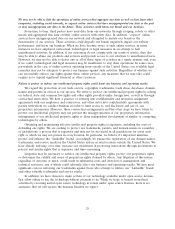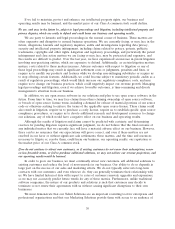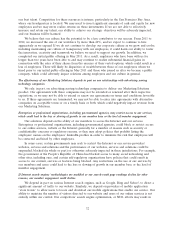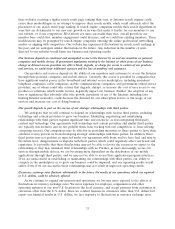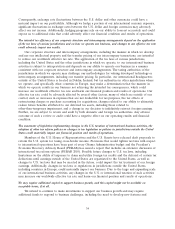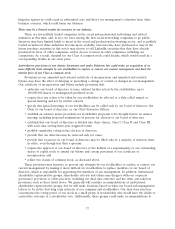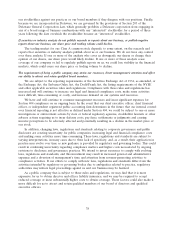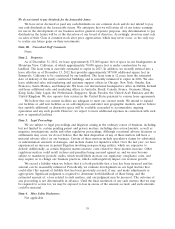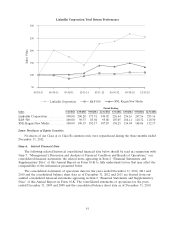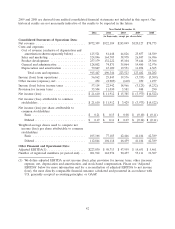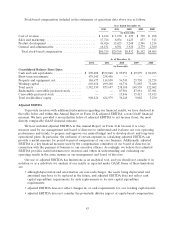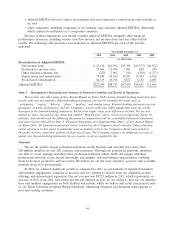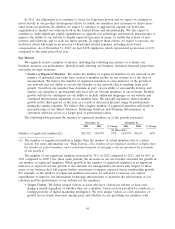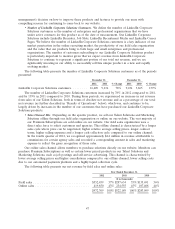LinkedIn 2012 Annual Report Download - page 39
Download and view the complete annual report
Please find page 39 of the 2012 LinkedIn annual report below. You can navigate through the pages in the report by either clicking on the pages listed below, or by using the keyword search tool below to find specific information within the annual report.litigation against us could result in substantial costs and divert our management’s attention from other
business concerns, which could harm our business.
There may be a limited market for investors in our industry.
There are few publicly traded companies in the social and professional networking and related
industries at this time, and, in fact, we were among the first social networking companies to go public.
Investors may have limited funds to invest in the social and professional networking sector, and as publicly
traded securities in these industries become more available, investors who have purchased or may in the
future purchase securities in this sector may choose to sell LinkedIn securities that they have already
purchased in favor of other companies, and/or choose to invest in other companies, including our
competitors. As a result, demand for our Class A common stock could decline, which would result in a
corresponding decline in our stock price.
Anti-takeover provisions in our charter documents and under Delaware law could make an acquisition of us
more difficult, limit attempts by our stockholders to replace or remove our current management and limit the
market price of our Class A common stock.
Provisions in our amended and restated certificate of incorporation and amended and restated
bylaws, may have the effect of delaying or preventing a change of control or changes in our management.
Our certificate of incorporation and bylaws include provisions that:
• authorize our board of directors to issue, without further action by the stockholders, up to
100,000,000 shares of undesignated preferred stock;
• require that any action to be taken by our stockholders be effected at a duly called annual or
special meeting and not by written consent;
• specify that special meetings of our stockholders can be called only by our board of directors, the
Chair of our board of directors, or our Chief Executive Officer;
• establish an advance notice procedure for stockholder proposals to be brought before an annual
meeting, including proposed nominations of persons for election to our board of directors;
• establish that our board of directors is divided into three classes, Class I, Class II and Class III,
with each class serving three-year staggered terms;
• prohibit cumulative voting in the election of directors;
• provide that our directors may be removed only for cause;
• provide that vacancies on our board of directors may be filled only by a majority of directors then
in office, even though less than a quorum;
• require the approval of our board of directors or the holders of a supermajority of our outstanding
shares of capital stock to amend our bylaws and certain provisions of our certificate of
incorporation; and
• reflect two classes of common stock, as discussed above.
These provisions may frustrate or prevent any attempts by our stockholders to replace or remove our
current management by making it more difficult for stockholders to replace members of our board of
directors, which is responsible for appointing the members of our management. In addition, institutional
shareholder representative groups, shareholder activists and others may disagree with our corporate
governance provisions or other practices, including our dual class structure and the other anti-takeover
provisions, such as those listed above. We generally will consider recommendations of institutional
shareholder representative groups, but we will make decisions based on what our board and management
believe to be in the best long term interests of our company and stockholders. Our dual class structure
concentrates the voting power of our stock in a small group of stockholders who would have the ability to
control the outcome of a stockholder vote. Additionally, these groups could make recommendations to
37




